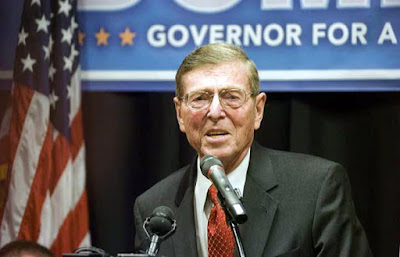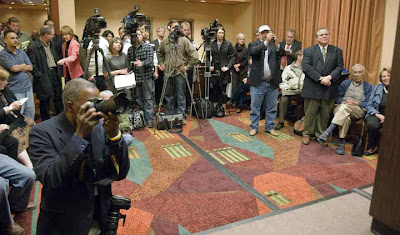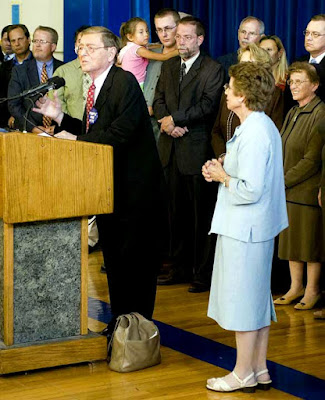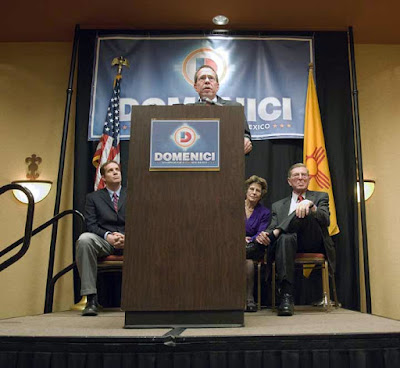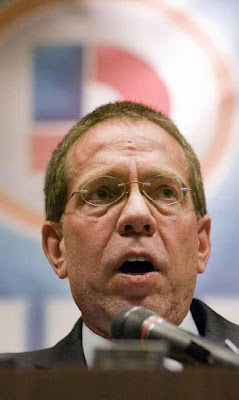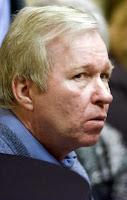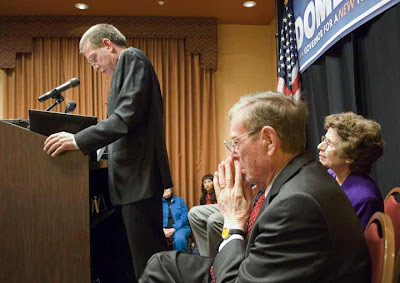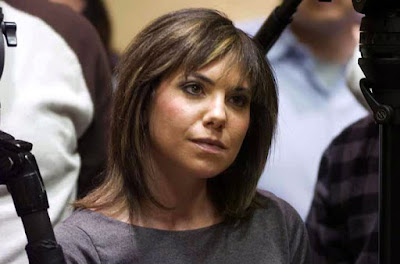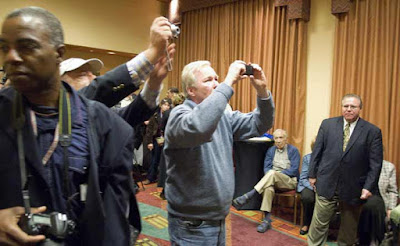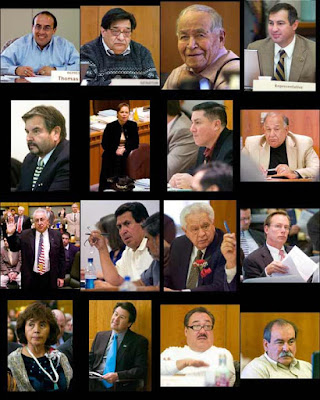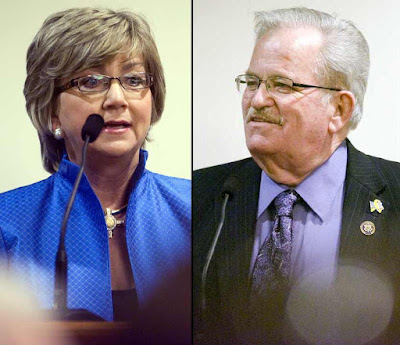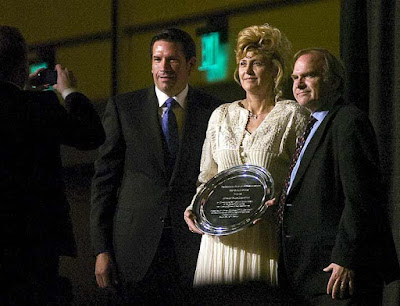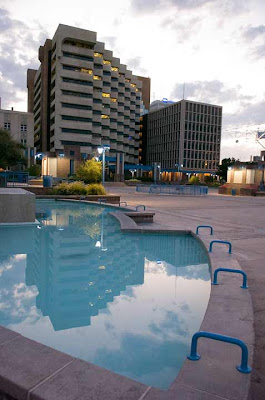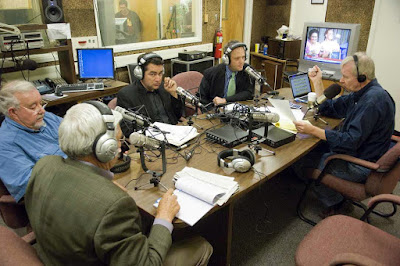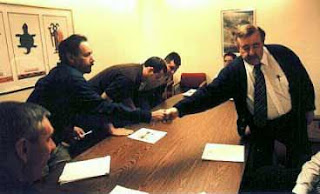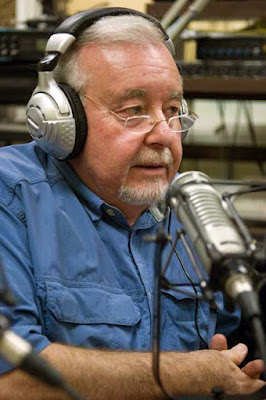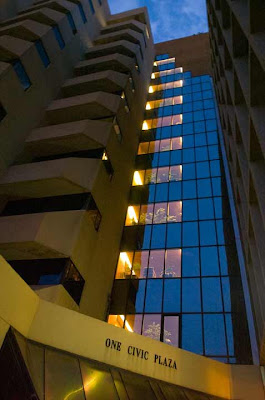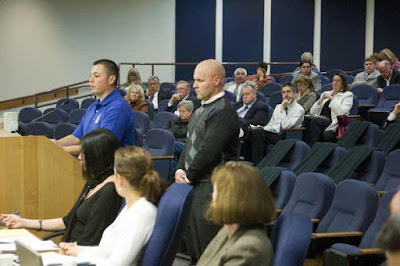I was up in Santa Fe at the beginning of the month and stopped by the Senate chambers to assess possible camera locations for webcasting the 30-day session, which began January 19.
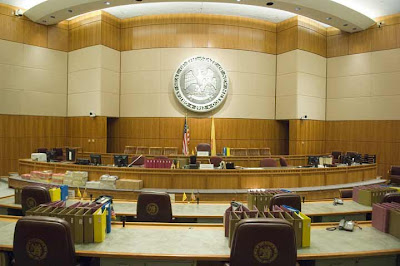 There, mounted on the front wall, were two of the remote-controlled video cameras. These cameras had been installed before last year’s session as a result of the year before, when the Senate approved live webcasting of their floor activities. Just days before the 2009, 60-day session, the Senate Committee on Committees voted to remove the cameras dashing the hopes of citizens of New Mexico from viewing their legislators in action.
There, mounted on the front wall, were two of the remote-controlled video cameras. These cameras had been installed before last year’s session as a result of the year before, when the Senate approved live webcasting of their floor activities. Just days before the 2009, 60-day session, the Senate Committee on Committees voted to remove the cameras dashing the hopes of citizens of New Mexico from viewing their legislators in action.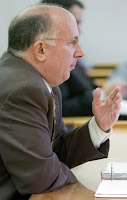 State Senator Mark Boitano, left, R, Bernalillo County, has carried legislation to open the Senate to webcasting since, at least 2005.
State Senator Mark Boitano, left, R, Bernalillo County, has carried legislation to open the Senate to webcasting since, at least 2005.In 2008, by way of a memorial, the Senate paved the way to webcast when it appropriated $75,000 to the broadcasting effort.
Remotely operated cameras and control equipment was purchased and installed in anticipation of the 60-day session.
The Senate Committee’s Committee blamed the economy for their decision not to use $30,000 of the $75,000 previously appropriated to the broadcasting effort according to the santafenewmexican.com, posting, "Budget crunch delays session webcasting," whose link has since been removed .
Sen. Mark Boitano’s 2009 bill, SB 401 and resolution, SR 3 addressed webcasting. The issue has been addressed since passage back in 2005, of a different measure sponsored by him.
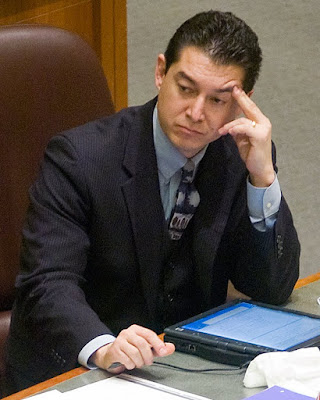 Near the end of the 2009 Legislature, during an evening session Senate Resolution 3, “Senate Live Audio and Video Web Streaming,” came to the floor, Sen. John Sapien, left, D, Sandoval County was prepared to introduce three amendments.
Near the end of the 2009 Legislature, during an evening session Senate Resolution 3, “Senate Live Audio and Video Web Streaming,” came to the floor, Sen. John Sapien, left, D, Sandoval County was prepared to introduce three amendments.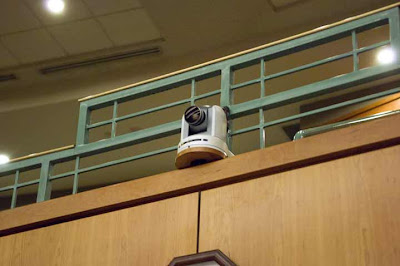 After a short but intense procedural wrangle there was an agreement to allow one stationary camera to be placed at the back of the chambers that overlooked nine, mostly balding, Senators and the President of the Senate, Denish’s seat.
After a short but intense procedural wrangle there was an agreement to allow one stationary camera to be placed at the back of the chambers that overlooked nine, mostly balding, Senators and the President of the Senate, Denish’s seat.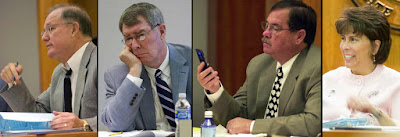 The Senate Rules Committee was an easy choice for aiming the camera for webcasting. Four of the eight members of the Senate Committee’s Committee who voted to remove the installed cameras from the chamber also sit on the Senate Rules Committee. They were Senate Majority Leader Michael Sanchez, D, Valencia County, Senate Minority Leader Stuart Ingle, R, Chaves, Curry, De Baca and Roosevelt Counties, President Pro Tem Timothy Jennings, D, Chaves, Eddy, Lincoln and Otero Counties, with Committee Chair Linda Lopez, D, Bernalillo County. The Rules Committee is the funnel for all Senate ethics bills.
The Senate Rules Committee was an easy choice for aiming the camera for webcasting. Four of the eight members of the Senate Committee’s Committee who voted to remove the installed cameras from the chamber also sit on the Senate Rules Committee. They were Senate Majority Leader Michael Sanchez, D, Valencia County, Senate Minority Leader Stuart Ingle, R, Chaves, Curry, De Baca and Roosevelt Counties, President Pro Tem Timothy Jennings, D, Chaves, Eddy, Lincoln and Otero Counties, with Committee Chair Linda Lopez, D, Bernalillo County. The Rules Committee is the funnel for all Senate ethics bills.On the House side, Representative Janice Arnold-Jones took her computer with a webcam to her committee meetings and set off a firestorm.
 So what’s wrong with this picture?
So what’s wrong with this picture?Part of the online response to live webcasting idea is to allow citizens to watch the legislators live and to e-mail their lawmakers directly to add to the debate.
My first thought was hopefully, that if the cameras were up there might have been some change of heart and some backroom deal, similar to last year’s changing course again.
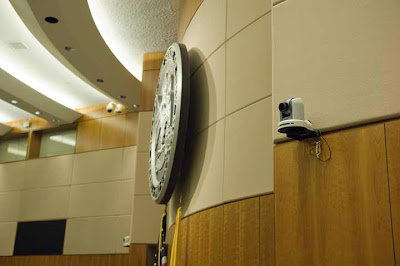 However, nothing has changed, the cameras were up so the Legislative Council Services technicians could do some testing, according to the LSC Communications Director John Yeager. LSC is just making sure that they are ready, if there should be any action to broadcast. The cameras were uninstalled before Tuesday's opening.
However, nothing has changed, the cameras were up so the Legislative Council Services technicians could do some testing, according to the LSC Communications Director John Yeager. LSC is just making sure that they are ready, if there should be any action to broadcast. The cameras were uninstalled before Tuesday's opening. My Take
My TakeThe new social media advocates suggest that instant communications with lawmakers during floor debates might add positively to the legislative process. However, it is questionable and problematic, at best.
Law making should be a deliberative process and citizens who want to participate should be well prepared about the issues and have communicated their concerns well before the final debate.
There are several reasons why this is not such a good idea.
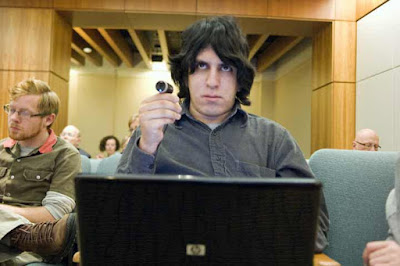 This is the New Mexico Independent's Reporter Matthew Reichbach, above, holding a small webcam during a Senate Judiciary meeting Friday Jan. 22, 2010. He was also "live blogging," giving a running commentary on what bill was being discussed and who was talking. People viewing often engage in an open forum that often times has little to do with the issue at hand. Live blogging may be useful to those watching, just not helpful to legislators making a decision at the moment.
This is the New Mexico Independent's Reporter Matthew Reichbach, above, holding a small webcam during a Senate Judiciary meeting Friday Jan. 22, 2010. He was also "live blogging," giving a running commentary on what bill was being discussed and who was talking. People viewing often engage in an open forum that often times has little to do with the issue at hand. Live blogging may be useful to those watching, just not helpful to legislators making a decision at the moment.In his 1995, book, "The Electronic Republic: Reshaping Democracy in the Information Age," Lawrence K. Grossman explored the use of the then burgeoning internet and contemplated its use to flatten the representative form of government and have citizens communicate directly with their legislators. He noted the increased use of ballot initiatives and pondered whether to allow citizens the ability to vote directly on every piece of legislation.
Grossman wrote of several factors to take into consideration:
“The distorting influence of money and other concerns,”He also predicted that rise of information, but did not perceive the decline in newspapers. He acknowledged the small number of people who controlled the vast majority of “news” media outlets.
“The professionalization of politics,”
“The rise of Interest politics,”
“’Dumbing down’ the quality of information.”
 I threw down a gauntlet during last year's debate over turning on the Senate controlled cameras. My challenge was that if the Senate did not video cast the floor activities adequately, á la C-SPAN, I would webcast their activities.
I threw down a gauntlet during last year's debate over turning on the Senate controlled cameras. My challenge was that if the Senate did not video cast the floor activities adequately, á la C-SPAN, I would webcast their activities. My blogging buddy Ched Mac Quigg, Diogenes' Six, above left, and I have pointed our camera at the Senate floor several times and attended the senate Judiciary Committee to allow the public an open glimpse.
My blogging buddy Ched Mac Quigg, Diogenes' Six, above left, and I have pointed our camera at the Senate floor several times and attended the senate Judiciary Committee to allow the public an open glimpse.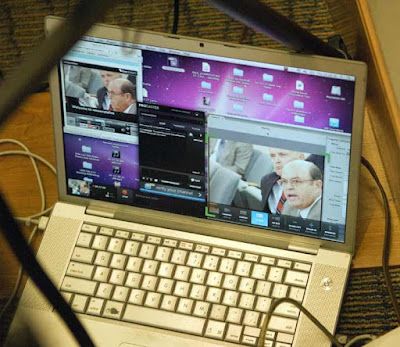 We experienced some major technical difficulties with the internet, but believe we have overcome them. We upgraded our equipment and tested it and will start webcasting today.
We experienced some major technical difficulties with the internet, but believe we have overcome them. We upgraded our equipment and tested it and will start webcasting today.We will be covering the Senate floor activities. Though we can’t promise wall-to-wall coverage we will do the best we can.
We can be found by linking to NM Senate Live.
By some stretch of irony, we will be covering the House Rules and Order of Business Committee, which is taking up the issue of webcasting House activities.
This is the committee which, last year was the scene of the battle over letting Rep. Arnold-Jones continue to webcast her assigned Committee hearings.
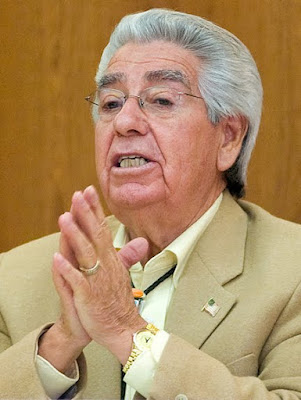 Speaker of the House Ben Lujan, above, seems to be no fan of transparency despite his rhetoric, he attempted to run rough shod over citizens who dare to video House activities this week, according to the New Mexico Independent's Larry Behrens, posting, "Webcam measure tabled in the House."
Speaker of the House Ben Lujan, above, seems to be no fan of transparency despite his rhetoric, he attempted to run rough shod over citizens who dare to video House activities this week, according to the New Mexico Independent's Larry Behrens, posting, "Webcam measure tabled in the House."Forgetting his basic civics lesson on the First Amendment:
Congress shall make no law… abridging the freedom… of the press…The current House rules allow for videoing committee meetings with the permission of the chair.
Yet the First prohibits government from requiring the asking of citizens to watch, participate and to disseminate what they see and hear to their fellow citizens.
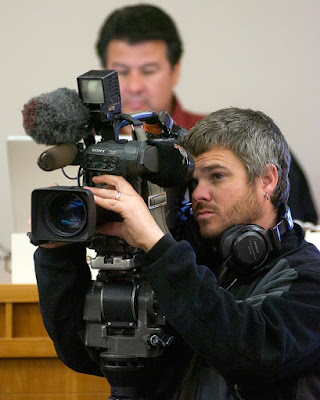 The commercial media don't ask, they're welcomed; no such thing as bad publicity.
The commercial media don't ask, they're welcomed; no such thing as bad publicity.I don't seek permission form government to exercise a Constitutional right.
If we get through that Constitutional test, then we will be back on the Senate side.
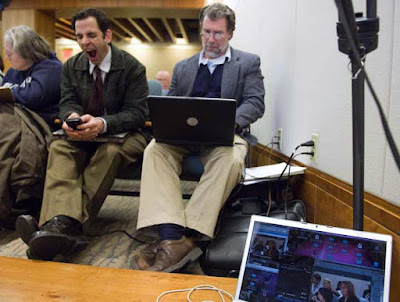 Watching the legislative process can be incredibly boring, Just ask KRQE's Anchor/Capitol Reporter Michael Herzenberg, sitting with the New Mexico Independent's Reporter Trip Jennings.
Watching the legislative process can be incredibly boring, Just ask KRQE's Anchor/Capitol Reporter Michael Herzenberg, sitting with the New Mexico Independent's Reporter Trip Jennings.There still are some legislators, like Rep. Gail Chasey, D, Bernalillo County, who as a member of the House Rules Committee, told the hearing that she is afraid that images on webcasts will be used against law makers in negative campaign ads.
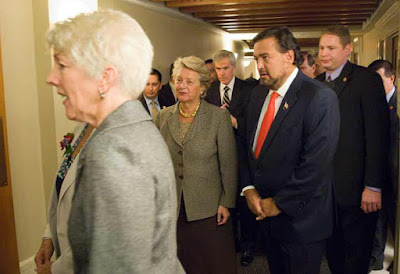 Chasey, left, was one of the House delegation sent to escort Governor Bill Richadson and his entourage, including his wife Barbara Richardson, and US Senator Jeff Bingaman, to the House chambers to give his state of the State address.
Chasey, left, was one of the House delegation sent to escort Governor Bill Richadson and his entourage, including his wife Barbara Richardson, and US Senator Jeff Bingaman, to the House chambers to give his state of the State address.Chasey should not worry about webcasting under the control of the Legislative Council Services technicians; it's the average citizen or hired ad agency video crew of whom she needs to be wary.
The efforts of NM Senate Live are nothing more than a nudge to have both branches of the legislature broadcast their proceedings for the citizens of New Mexico to watch.
 Capitol Report New Mexico dies again, or does it?
Capitol Report New Mexico dies again, or does it?Another final issue of Capitol Report New Mexico was published just before the session. A Rio Grande Foundation grant funded the publication for just over a year. The Foundation chose to go another way.
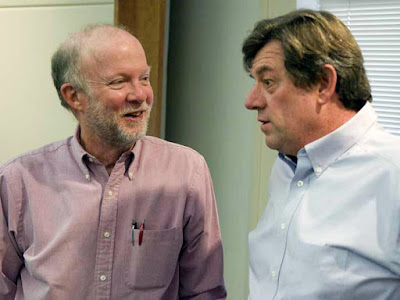 Seeking future funding, Editor Harold Morgan, left, interviewing House Minority Leader Tom Taylor R McKinley County.
Seeking future funding, Editor Harold Morgan, left, interviewing House Minority Leader Tom Taylor R McKinley County.Though a niche product, specializing in the numbers of the State’s budgeting process, it has provided analytical viewpoints from well-regarded observers of the inner working of policy making. Regular contributors included: New Mexico State University History and Political Science Professor Dr. Jose Z. Garcia, who blogs, “La Politica: New Mexico! La Voz del Valle del Sur,“ University of New Mexico Department of Political Science Professor and Regents Lecturer Dr. Lonna Atkeson, President and Executive Director of the New Mexico Tax Research Institute Richard L. Anklam, New Mexico’s Rio Grande Foundation President Paul Gessing, and several guest writers.
I provided the photography and proofreading (any typographical errors are a testament to my lack of skills as a copy editor).
CRNM has had a life as a slick magazine, a newsprint product and has a web presence. I predict we will continue reviving again when some more funding comes along.
